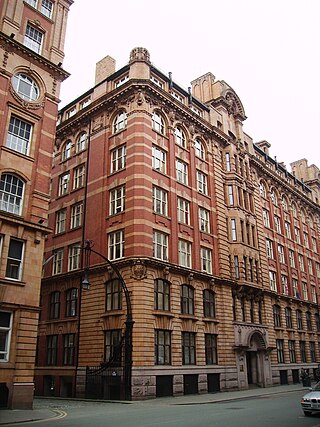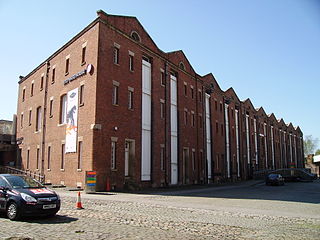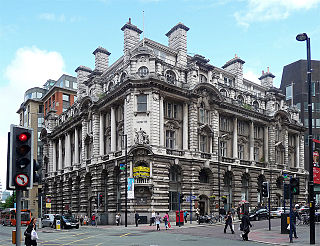
London Road Fire Station is a former fire station in Manchester, England. It was opened in 1906, on a site bounded by London Road, Whitworth Street, Minshull Street South and Fairfield Street. Designed in the Edwardian Baroque style by Woodhouse, Willoughby and Langham in red brick and terracotta, it cost £142,000 to build and was built by J. Gerrard and Sons of Swinton. It has been a Grade II* listed building since 1974.

King Street is one of the most important thoroughfares of Manchester city centre, England. For much of the 20th century it was the centre of the north-west banking industry but it has become progressively dominated by upmarket retail instead of large banks.

George Corson (1829–1910) was a Scottish architect active in Leeds, West Yorkshire, England.

Ellen Wilkinson High School was housed, until it closed in 2000, in a Grade II* listed building in Ardwick, Manchester, England, designed in 1865–67 by the prolific Manchester architect Thomas Worthington. Formerly known as Nicholls Hospital, the building was funded by Benjamin Nicholls as a memorial to his son, John Ashton Nicholls. Nicholls commissioned Worthington to prepare designs, with instructions that building was only to commence after his own death. It was built in 1878–1880 and Worthington's last significant commission in the city. The original usage was as an orphanage; the Ashton family gave over £100,000 to its construction and endowment.

Asia House at No. 82 Princess Street, Manchester, England, is an early 20th century packing and shipping warehouse built between 1906 and 1909 in an Edwardian Baroque style. It is a Grade II* listed building as at 3 October 1974. Nikolaus Pevsner's The Buildings of England describes the warehouse, and its companion, No. 86, Manchester House, as "quite splendid ... good examples of the warehouse type designed for multiple occupation by shipping merchants". It attributes its design to I.R.E. Birkett, architect of the Grade II listed companion building, Manchester House, which is similar in design. English Heritage attributes it to Harry S. Fairhurst. Asia House has an "exceptionally rich" entrance hall and stairwell, "lined with veined marble and green and cream faience, with designs of trees and Art Nouveau stained glass".

Lancaster House in Whitworth Street, Manchester, England, is a former packing and shipping warehouse built between 1905 and 1910 for Lloyd's Packing Warehouses Limited, which had, by merger, become the dominant commercial packing company in early 20th century Manchester. It is in the favoured Edwardian Baroque style and constructed with a steel frame clad with granite at the base and Accrington red brick and orange terracotta. The back of the building is plain red brick. It is a Grade II* listed building as of 2 October 1974.

India House in Whitworth Street, Manchester, England, is a packing and shipping warehouse built in 1906 for Lloyd's Packing Warehouses Limited, which had, by merger, become the dominant commercial packing company in early-20th century Manchester. It is in the favoured Edwardian Baroque style and is steel-framed, with cladding of buff terracotta and red brick with buff terracotta dressings. It is a Grade II* listed building as of 2 October 1974.

The Tootal, Broadhurst and Lee Building at No. 56 Oxford Street, in Manchester, England, is a late Victorian warehouse and office block built in a neo-Baroque style for Tootal Broadhurst Lee, a firm of textile manufacturers.

38 and 42 Mosley Street in Manchester, England, is a double-block Victorian bank constructed between 1862 and c. 1880 for the Manchester and Salford Bank. It is located on the corner of Mosley Street and York Street.

The former National Westminster Bank on Spring Gardens, Manchester, England, is an Edwardian bank building constructed in 1902 for Parr's Bank by Charles Heathcote. The bank is in a "bold Edwardian Baroque" style. It is a Grade II* listed building as of 4 January 1972.

Grove House, on Oxford Road, Chorlton-on-Medlock, Manchester, England, is an early Victorian building, originally three houses, of 1838–40. It is a Grade II* listed building as of 18 December 1963.

The 1830 warehouse, Liverpool Road, Manchester, England, is a 19th-century warehouse that forms part of the Liverpool Road railway station complex. It was built in five months between April and September 1830, "almost certainly [to the designs of] the Liverpool architect Thomas Haigh". The heritage listing report attributes the work to George Stephenson and his son, Robert. It has been listed Grade I on the National Heritage List for England since May 1973.

Brownsfield Mill, located on Binns Place, Great Ancoats Street in Manchester, England, is an early 19th century room and cotton-spinning power mill constructed in 1825. Hartwell describes it as "unusually complete and well preserved". The chimney is now Manchester's oldest surviving mill chimney. The building housed the A.V. Roe and Company aviation factory in the early 20th century. In 1988, it was designated a Grade II* listed building.

53 King Street is an Edwardian Baroque bank on King Street in Manchester, England. Designed by architect Charles Heathcote, it opened in 1913 and was granted Grade II listed building status in 1974. It used to house a branch of Lloyds TSB. In 2009, the building was sold for £6 million. The building stands on the site of the old Manchester Town Hall.

Canada House is an Art Nouveau-style office building on Chepstow Street in Manchester, England. Constructed originally as a packing warehouse, the building opened in 1909. Designed by local architects W & G Higginbottom, the building has features consistent with art nouveau and has a terracotta exterior.

The Redfern Building is a Grade-II listed building which was completed in 1936 in Manchester, England. The building is situated on Dantzic Street and meets the junction of Mayes Street and Hanover Street. Redfern was originally built for office and warehouse use.

46–48 Brown Street is a Grade II listed building in Manchester, England. Situated in the Spring Gardens area of Manchester city centre near King Street, it was home to Brook's Bank. The building is also known as Lombard Chambers.
There are many Grade II listed buildings in the City of Manchester, England. The majority of Manchester's listed buildings date from the Victorian (1837–1901) and Edwardian era (1901–1911), most as a consequence of the Industrial Revolution. In England and Wales the authority for listing is granted by the Planning Act 1990 and is administered by English Heritage, an agency of the Department for Digital, Culture, Media and Sport. There are three categories of listing – Grade I, Grade II* and Grade II.

Victoria Mill is a Grade II* listed 19th-century cotton spinning mill in Miles Platting, Manchester, England. It was a double mill designed by George Woodhouse and completed in 1869.

The Church of St John the Divine is a Church of England parish church in Brooklands, Sale, Greater Manchester. The church is a grade II* listed building.

























